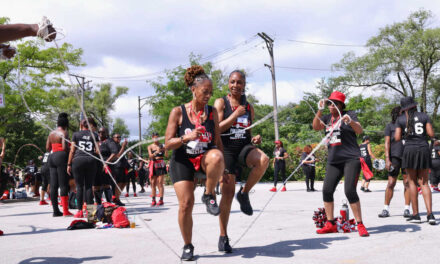Bill Lear stares at the plate, ready to pitch. Beneath his uniform he wears shin guards he fashioned from a downspout and a chest protector he made from a cookie sheet. A black helmet with a faceguard protects his head.
Lear is 85 years old, and his macular degeneration makes it tough for him to see, so the catcher doesn’t bother giving him signals. He rears back, grunts, and throws a fastball, up and in. The batter, 27 years younger than Lear, swings and misses. Strikeout.
“Exactly where I wanted it,” a hepped up Lear says, as he walks to the dugout.
In the region’s senior baseball circuit, Lear is both a star and an inspiration — an octogenarian playing a kid’s game when many his age would consider themselves fortunate not to need walkers. He plays baseball in three different area leagues and figures he throws about 150 pitches in weekend games at a time when major leaguers rarely throw more than 90.
As for his failing eyesight, he is sanguine. Sure, he often can’t see a line drive hit right at him for about half the distance from the plate, but that’s why he wears his version of under armor plus a helmet. His shin guards are dented from the many hard-hit balls they have deflected.
“He’s like a 12-year-old in an 80-year-old body,” said Tom Carroll, a one-time pitcher for the Cincinnati Reds, who plays against Lear in the aptly named Ponce De Leon League.
“Old man baseball,” as the players routinely call it, is the same game that’s played in Nationals Park except slower and stiffer. Lear plays in the Ponce’s 48-and-older division, and in the 50-plus and 60-plus divisions in another area league called the Men’s Senior Baseball League. A handful of women play in the leagues, though none on Lear’s team.
Runners are rarely thrown out stealing. Flyballs to the outfield regularly fall for hits.
But the ball they use is just about as hard as the one used in the major leagues and some batters smash it ferociously. Players go all out, risking injuries. When they are hurt, they mirror the tough-it-out style of big leaguers.
A line drive hit Lear’s 65-year-old MSBL teammate, Bob Smedile, in the left eye in 2019, breaking an ocular bone and giving him a concussion. “The thing I’m proud of is I didn’t go down,” Smedile said. “I stood there and took it.”
Lear, 5-foot-8 and a trim 175 pounds, didn’t start playing baseball until he was 64 when a friend talked him into it. Now he is the oldest player of the 450 or so that play in DMV baseball teams for those 48-and-older.
For decades, the former mechanical engineer only played slow-pitch softball, a far less demanding game where a pitcher floats a larger, softer ball over the plate. (The unofficial motto of MSBL players: “Don’t be soft. Play hardball.”) Lear played outfield and always prided himself on his strong arm, which he figures he developed by throwing rocks at telephone poles when he grew up in rural Howard County.
In his first try at baseball, Lear says he threw nearly 80 miles per hour (major league pitchers top 90), giving him one of the best fastballs in the Ponce senior leagues. Over the years his velocity diminished to the mid-50s, but he developed a variety of curveballs, sliders and sinkers that dip and break which he taught himself through YouTube videos and tips from other pitchers. His catchers say he keeps batters off kilter, so they lunge at the ball and rarely make hard contact.
He experiments in the backyard of his Bethesda home where he pitches into netting marked with a strike zone divided into six squares. He works at consistently dropping pitches into the bottom right corner. “Did you see that one?” he said, as animated as a Little Leaguer, after a sinker did just what he wanted it to do.
“That’s what the game is to me,” he said. “To make that one great pitch and have the guys behind me say, ‘wow.’”
He says he has picked up a few tricks. Sometimes, he puts sticky pine tar on his knuckles to help him throw a knuckleball that dips and turns. Other times he wears a plastic surgeon’s glove to get a better grip on a curveball. And sometimes he uses his macular degeneration to try to psych out a batter afraid of getting hit. “Damn, right I do,” he said.
As he has aged, he has become something of a mythical figure to younger players, who trade stories about being bested by an ancient pitcher. Josh Corbin, a smooth-fielding shortstop, said that the first time he played senior baseball a few years back when he was 51, he struck out against Lear. “It’s not that he throws hard, but his pitches move,” said Corbin, a neuroscience researcher. “It’s hard to hit a ball that moves.”
Unlike Lear, Carroll, the former Reds pitcher, no longer pitches. At age 70, Carroll, can’t perform at the level he once could, he said, and there is no glory for him pitching to old-timers. “If I give up a long hit, guys will say I got a hit off a major league pitcher,” he said. So he plays third base, sometimes diving for hard-hit grounders despite having an artificial hip.
Lear attributes his pitching longevity to throwing mostly curveballs and sliders, which he figures puts less pressure on his arm than fastballs. But Glenn Fleisig, director of biomechanics research at the American Sport Medicine Institute, says the type of pitch doesn’t matter much. Pitchers injure themselves by throwing as hard as they can on each pitch, he said, and not allowing enough time between games for recovery. Varying the speed of pitches, as Lear does, is optimal. Still, he calls Lear ‘s longevity “absolutely remarkable.”
Lear has blown through plenty of warning signs that suggest he should give up the game. He has ruptured a disk while sliding, torn a shoulder muscle while checking a swing, broken a leg when hit by a ball, and broken his arm while throwing a fastball. In all those cases, he rested for some months and played again as soon as possible. He calls the time when he isn’t able to play “the miserables.”
He comes alive at a game, talking to teammates, kibitzing with opponents, coaching third base when he isn’t scheduled to hit, and regaling visitors about his exploits.
At a recent Ponce game at Wheaton Regional Park, he started pitching in the third inning. “New pitcher alert — or should I say old pitcher,” shouted someone from the opposing dugout. The umpire leaned over Lear’s catcher, 78-year-old John Schneider, and said, “This must be the oldest battery in the world,” referring to the pitcher-catcher combination.
The first batter, 52-year-old Eric Heyse — more than 30 years younger than Lear — had the look of an athlete — tall, lanky and relaxed. Chewing bubble gum, he waited for Lear to get ready. With the count at three balls, two strikes, the lefty Heyse smashed a low fastball just short of the right field fence 325 feet away, far enough for an extra-base hit. But it landed foul. Next, Lear tried to get him off balance with a fastball high and inside. Heyse swung and missed. Strikeout.
“Erase that from your memory right now; he’s 85,” teased a teammate as Heyse walked back to the dugout.
Afterward, Heyse, who owns an auto repair shop, was philosophical. “I don’t think about his age,” he said. “He’s a good competitor. I took a swing. He got me.” Later in the game, he hit a sacrifice fly to center field off Lear.
In all, Lear pitched four innings with mixed success on a day that was so sweltering his team’s 59-year-old third baseman worried he might faint. Lear allowed four runs in one inning in his team’s 15-4 loss, got three quick outs in another and was on the mound when the umpire ended the game in the eighth inning because it had reached the league limit of three hours.
One of Lear’s opposing pitchers in MSBL, 63-year-old Phil Daschner, said that after a long pitching stint like that, he puts his arm in a bucket of ice and takes an Advil. “If he doesn’t do that, his arm must be bionic,” he said of Lear.
Rather than searching for ice after the game, Lear popped open the trunk of his 1963 Dodge Polara 500, with a red racing stripe, which was once used for drag racing. (Lear used to drag race, but Fords not Dodges.) Inside were four baseball shoes, seven bats and a cooler. What’s his postgame recovery plan?
“A cold beer,” he said.




